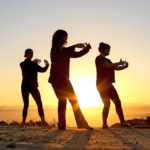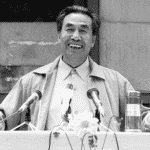“…Cultivating one’s life energy (Qi) is not the most fundamental; cultivating one’s spirit is. Mastery of Qi is really achieved through mastery of consciousness. We use consciousness in a careful, craftsman like way, to shape our life, to attain our goals… The ancients used the word Qi and this mystifies modern people. But in modern terms, Qigong is just the refinement of consciousness to enhance the state of energy in the body. This leads to vibrant health, a harmonious body and mind, and an awakened spiritual life.” – Dr. Ming Pang, Originator of Zhineng Qigong
Overview of Qigong
Qigong – pronounced “chee gung” – is an ancient Chinese healing art and health care system that integrates physical postures, movement, breathing techniques and focused intention. Self massage, sounds and mudras are also sometimes included. Qigong practice is suitable for everyone, of all ages, and can be practiced standing, seated and even lying down.
Qigong is a simple, yet profound practice that strengthens self-healing abilities and improves physical, emotional and mental well being. It helps to prevent disease, and increase vitality and longevity. Practitioners often report feelings of harmony, tranquility and peacefulness along with a greater connection to life’s purpose.
Qigong has an immense and rich history. Originally, the natural world; the earth and sky, all living beings on earth, along with the sun and stars in our galaxy supported ancient people to live in harmony with nature.
Qigong was later also influenced by many wisdom traditions such as Daoism, Buddhism, Hinduism and Confucianism. Qigong is not a religion, however, it has spiritual aspects. Traditional and Classical Chinese Medicine also play a part in many qigong systems practiced today.
 Types of Qigong
Types of Qigong
There are several types of qigong available to us. They each have unique intentions, methods and traditions. You can think of qigong as the trunk of a sturdy, vital tree. The many strong branches reaching out in different directions are the types of qigong systems available to you. Same trunk, many branches.
Within the different types of qigong, there is much crossover. You may experience several types of qigong in one system or even in one form. It is common to practice using self-healing intentions and spiritual visualizations in all systems.
All types of qigong are beneficial, one is not better than the other. Benefits will be relative to what type calls to you and your own practice. Qi is unlimited. It can open up possibilities never before considered.
The terms to define the different types of qigong are evolving and being refined, however, for now they can be generally described as:
Self-Healing/Medical/Longevity Qigong: The intention for this type of qigong is through cultivation of self-healing abilities to prevent and recover from dis-ease while improving vitality, balance, well-being and longevity. Strength, flexibility and overall fitness are improved. Reduction of pain and stress are commonly experienced even during the first few practice sessions.
Spiritual Qigong: Practices are non religious and done with moving and seated meditation. They are directed towards a deeper conscious connection with all aspects of life. These include the physical, mental, emotional and spiritual aspects. The focus is to cultivate a sense of oneness with ourselves, all living beings and the cosmos. Spending time in stillness strengthens the connection to ourselves and brings inner peace.
Energy Healing/Clinical Qigong: Professionals are trained to transmit qi to clients for healing. They also make recommendations for exercises, food and/or meditations to help restore balance.
Martial Qigong: The focus is on learning and cultivating defensive martial skills which include graceful movements that are grounded and agile.
Qigong for Life Practices
Qigong for Life offers practices that incorporate many forms, movements and meditations to help students get the most benefits. Here’s some we offer:

Dr. Pang Ming
Zhineng Qigong is considered one of the most accessible and effective systems. It was created by Dr. Pang Ming, an extraordinary qigong Grandmaster. He founded the largest physician-staffed energy-healing hospital in China, where Zhineng Qigong was used to study body-mind science and its applications to self-healing.
The Zhineng Qigong Center, which closed in 2001 due to political changes, treated more than 200,000 patients. Patients came to the Center with over 185 different diseases. 95+% of patients showed improvement. Results from the data collected at the Center are described in this paper. This 1994 interview with Dr. Pang is insightful and inspiring.
Zhineng Qigong Practices offered by Qigong for Life include: Organizing the Qi Field meditation, Lift Qi Pour Qi Down, the HYLT Mantra, Body Mind Method, Standing Meditation, Hun Yuan and Yi Yuan Ti Theory and others.
Qigong Breathing Exercises consist of an opening meditation, three distinct breathing methods, head massages and a closing meditation.
The preparatory or opening meditation is to open mind and heart. Through this meditation we become centered, grounded and more connected with nature. This alone promotes overall wellness by reducing stress and making space for increased wellness and happiness.
The exercises are designed to activate and achieve resonance of the three main dantians in the body. They each employ specific hand positions (mudra). Read more.
Circle Walking activates and enhances digestion especially when practiced after eating. It regulates body weight and helps loosen up your lower back while also keeping you nimble and fit. Circle walking enhances qi and blood circulation in the lower limbs and generates qi in lower dantian, which strengthens your whole being. Read more.
